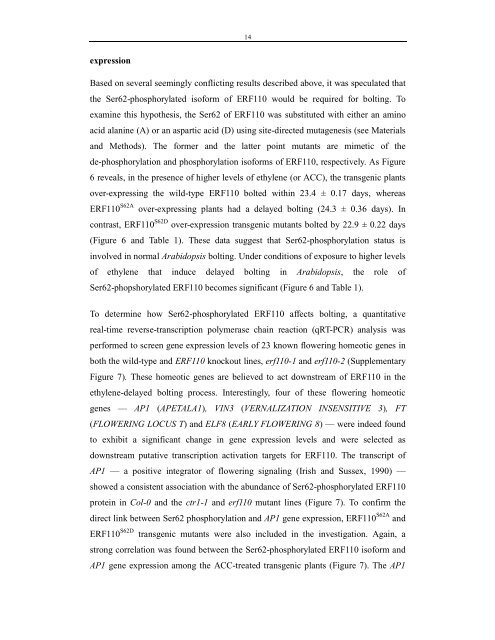Phosphoproteomics-identified ERF110 affects ... - Plant Physiology
Phosphoproteomics-identified ERF110 affects ... - Plant Physiology
Phosphoproteomics-identified ERF110 affects ... - Plant Physiology
Create successful ePaper yourself
Turn your PDF publications into a flip-book with our unique Google optimized e-Paper software.
expression<br />
14<br />
Based on several seemingly conflicting results described above, it was speculated that<br />
the Ser62-phosphorylated isoform of <strong>ERF110</strong> would be required for bolting. To<br />
examine this hypothesis, the Ser62 of <strong>ERF110</strong> was substituted with either an amino<br />
acid alanine (A) or an aspartic acid (D) using site-directed mutagenesis (see Materials<br />
and Methods). The former and the latter point mutants are mimetic of the<br />
de-phosphorylation and phosphorylation isoforms of <strong>ERF110</strong>, respectively. As Figure<br />
6 reveals, in the presence of higher levels of ethylene (or ACC), the transgenic plants<br />
over-expressing the wild-type <strong>ERF110</strong> bolted within 23.4 ± 0.17 days, whereas<br />
<strong>ERF110</strong> S62A over-expressing plants had a delayed bolting (24.3 ± 0.36 days). In<br />
contrast, <strong>ERF110</strong> S62D over-expression transgenic mutants bolted by 22.9 ± 0.22 days<br />
(Figure 6 and Table 1). These data suggest that Ser62-phosphorylation status is<br />
involved in normal Arabidopsis bolting. Under conditions of exposure to higher levels<br />
of ethylene that induce delayed bolting in Arabidopsis, the role of<br />
Ser62-phopshorylated <strong>ERF110</strong> becomes significant (Figure 6 and Table 1).<br />
To determine how Ser62-phosphorylated <strong>ERF110</strong> <strong>affects</strong> bolting, a quantitative<br />
real-time reverse-transcription polymerase chain reaction (qRT-PCR) analysis was<br />
performed to screen gene expression levels of 23 known flowering homeotic genes in<br />
both the wild-type and <strong>ERF110</strong> knockout lines, erf110-1 and erf110-2 (Supplementary<br />
Figure 7). These homeotic genes are believed to act downstream of <strong>ERF110</strong> in the<br />
ethylene-delayed bolting process. Interestingly, four of these flowering homeotic<br />
genes –– AP1 (APETALA1), VIN3 (VERNALIZATION INSENSITIVE 3), FT<br />
(FLOWERING LOCUS T) and ELF8 (EARLY FLOWERING 8) –– were indeed found<br />
to exhibit a significant change in gene expression levels and were selected as<br />
downstream putative transcription activation targets for <strong>ERF110</strong>. The transcript of<br />
AP1 –– a positive integrator of flowering signaling (Irish and Sussex, 1990) ––<br />
showed a consistent association with the abundance of Ser62-phosphorylated <strong>ERF110</strong><br />
protein in Col-0 and the ctr1-1 and erf110 mutant lines (Figure 7). To confirm the<br />
direct link between Ser62 phosphorylation and AP1 gene expression, <strong>ERF110</strong> S62A and<br />
<strong>ERF110</strong> S62D transgenic mutants were also included in the investigation. Again, a<br />
strong correlation was found between the Ser62-phosphorylated <strong>ERF110</strong> isoform and<br />
AP1 gene expression among the ACC-treated transgenic plants (Figure 7). The AP1

















